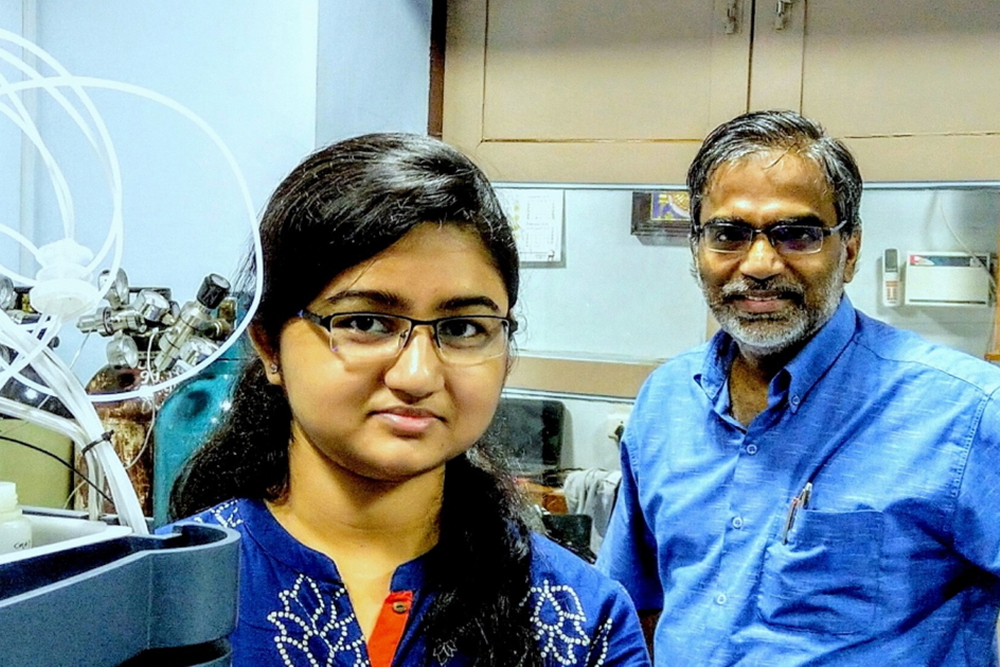‘Music Chair’ of Atoms at the Nanoscale CHENNAI
-Navneet Kr. Gupta
Atoms in small particles of metals move between each other within a blink of an eye, Prof. T. Pradeep and colleagues have found. Atoms in metals such as gold and silver practically stay at their locations for eternity which make them stable and noble. Chemical and physical processes do not move atoms between particles easily, which explains their stability. However, in nanometer-scale particles, this is completely different, recent studies have shown.
This ‘dance of atoms’ is similar to that in water molecules where protons (hydrogen nuclei) move between water (H2O) molecules, even down to very low temperatures. This movement makes pure water and ice electrically conducting to a slight extent.
The Research was undertaken by Ms. Papri Chakraborty, Research Scholar, IIT Madras and her colleagues under the direction of Prof T. Pradeep, Institute Professor, and Deepak Parekh Institute Chair Professor, Department of Chemistry, IIT Madras. The work was published recently in Science Advances.
Speaking about the importance of this Research, Prof Pradeep said, “This question our fundamental idea of how nanoparticles behave in solutions.”
Highlighting the applications of this research, Prof Pradeep added, “In case of homogeneous catalysis, an important application of nanomaterials, the site on the nanoparticles at which chemistry occurs could be changing spontaneously. The dynamics are also important in biology where nanoparticles are used as drug carriers.”
In the experiment, researchers prepared 1 nm particles of silver composed of 25 atoms, protected with molecules called ligands. Such protected metal particles are called clusters and they are made by solution chemistry.
Speaking about her findings, Ms. Papri Chakraborty said, “Our study answers fundamental questions regarding the dynamics and interconversions of nanoparticles. It is interesting to observe that nanoparticles can behave as simple molecules like water.”
To test the hypothesis of atom transfer, researchers made identical 25 atom clusters with two isotopes of silver (107Ag and 109Ag). Isotopes are elements with the same atomic number but different atomic masses, and they are identical in chemical properties. Common examples are hydrogen (H) and deuterium (D) which are isotopes of hydrogen with the same chemical properties. However, they have different atomic masses. H2O and D2O are water with the same chemical properties, formed with hydrogen and deuterium.
In isolated state, Ag25 made of 107Ag isotope and Ag25 made of 109Ag isotope are equivalent in chemical properties. They have the same colour, same reactivity, same structure but different molecular masses.
In an instrument called a mass spectrometer, these two clusters show different masses. However, upon mixing these two clusters in solution and measuring the mass spectrum in solution, researchers found that the parent clusters disappeared completely and a new cluster of 25 atoms but a mixture of 107Ag and 109Ag atoms emerged. This was identical to the formation of a molecule of HDO from H2O and D2O when they both were mixed. Atoms of H and D exchange each other when normal water (H2O) and heavy water (D2O) are mixed.
Unusual chemistry - Mass spectra of the parent isotopically pure clusters and that of the product clusters, made by mixing the former.
The exchange of atoms could be slowed down by reducing the temperature and researchers have observed the in-between states of atom exchange in such experiments. By studying these, they have concluded that the atom transfer rate is similar to that in water.
Spontaneous atom transfer in nanoparticles implies their molecular nature. Atoms at the surface of such particles may be interacting with neighboring particles similar to that in molecules. The properties of nanoparticles such as catalysis, drug delivery, biological sensing, etc., may all be viewed differently in view of this rapid atom exchange.
------------------
 Navneet Kumar Gupta is a science communicator working as a Project Officer (Edusat) in Vigyan Prasar-National institute of Science communication under the Department. of Science & Technology. Govt. Of India. He has a deep interest in popular science writing for the general public through Print and electronic media. Besides his twelve books, he has written more than 200 popular science articles. He has edited/authored/co-authored more than 10 books. He has been awarded six National Awards including Rajbhasha Award, Ministry of Home Affairs, Government of India He has had a long stint as Associate Editor, VIPNET news - a popular science magazine. You may contact him at - ngupta@vigyanprasar.gov.in
Navneet Kumar Gupta is a science communicator working as a Project Officer (Edusat) in Vigyan Prasar-National institute of Science communication under the Department. of Science & Technology. Govt. Of India. He has a deep interest in popular science writing for the general public through Print and electronic media. Besides his twelve books, he has written more than 200 popular science articles. He has edited/authored/co-authored more than 10 books. He has been awarded six National Awards including Rajbhasha Award, Ministry of Home Affairs, Government of India He has had a long stint as Associate Editor, VIPNET news - a popular science magazine. You may contact him at - ngupta@vigyanprasar.gov.in
